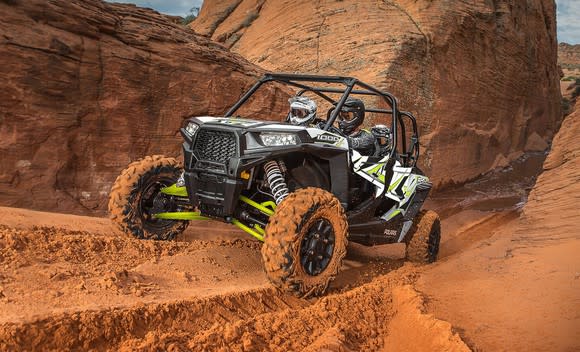Polaris' First-Quarter Report Showed Strength
Polaris Industries Inc. (NYSE: PII) announced strong first-quarter 2018 results on Tuesday morning, detailing improved production ahead of the peak retail selling season and its best-ever start to the year for off-road vehicle (ORV) sales. Polaris also modestly increased its full-year guidance.
Let's kick the tires and have a closer look at how Polaris kicked off 2018.

IMAGE SOURCE: POLARIS INDUSTRIES.
Polaris Industries results: The raw numbers
Metric | Q1 2018 | Q1 2017 | Year-Over-Year Growth |
|---|---|---|---|
Sales | $1.297 billion | $1.154 billion | 12.4% |
GAAP net income (loss) | $55.7 million | ($2.9 million) | N/A |
GAAP earnings per diluted share | $0.85 | ($0.05) | N/A |
Data source: Polaris Industries.
What happened with Polaris this quarter?
On an adjusted basis -- which excludes expenses related to the wind-down of Victory Motorcycles and inventory step-up costs from the integration of Transamerican Auto Parts (TAP) -- net income increased 41% to $69 million, or $1.06 per diluted share.
Both the top and bottom lines outpaced most investors' expectations for adjusted earnings of $0.88 per share on revenue of $1.21 billion.
Parts, garments, and accessories (PG&A) revenue, excluding aftermarket segment sales, increased 5% driven by accessories and apparel.
International sales (including PG&A) grew 27% (or 16% at constant currency) to $211 million.
ORV and snowmobile sales grew 15% year over year to $833 million, with strength across all categories.
ORV wholegood sales grew 17%, driven by Ranger, RZR, and ATV shipments. Polaris North American ORV retail-unit sales grew in the mid-single-digit percent range, setting a company record.
Snowmobile wholegood sales grew 28% to $18 million, driven by strong international sales. But Polaris' snowmobile retail sales declined in the high-single-digit percent range; Polaris lost market share during the quarter and season, partly because of a lack of snow in regions where it has the highest share relative to competitors.
Motorcycle sales grew 9% to $132 million, as low-double-digit growth from Indian motorcycles more than offset low-double-digit declines from Slingshot.
North American consumer retail demand for Indian motorcycles and Slingshot together increased in the low-single-digit percent range, outperforming a midteens percent decline from the broader motorcycle industry (900cc and above).
Global adjacent market revenue grew 24% to $113 million, including double-digit growth from both Aixam and the commercial/government/defense group.
Aftermarket segment sales grew 1% to $220 million, including a slight decline in TAP aftermarket accessory revenue due to soft light-duty truck industry sales.
What management had to say
Polaris CEO Scott Wine stated:
We delivered record first-quarter off-road vehicle retail sales to begin the year, driven by innovation and improved dealer engagement. This translated into strong revenue and earnings growth for the quarter. Through the tireless efforts of our team and the efficacy of various quality and productivity initiatives, we overcame commodity and freight inflation and product mix pressures in the first quarter to maintain our gross margin year over year, while leveraging operating expenses even as we continue to invest heavily in research and development.
Wine added that Polaris' production flow "improved steadily throughout the quarter," while inventory remains healthy.
Looking forward
As such, Polaris now expects full-year 2018 sales growth in the range of 4% to 6% (up from 3% to 5% previously), which should result in adjusted net income of $6.05 to $6.20 per share (compared to $6.00 to $6.20 per share before). Polaris also noted that this guidance takes into account roughly $15 million in incremental pre-tax costs related to recent commodity price increases, higher freight expenses, and estimated additional tariffs.
By comparison, however, consensus estimates from analysts already called for revenue at the midpoint of Polaris' new range, and for full-year earnings near the high end at $6.16 per share.
All things considered, apart from the geography-related weakness in snowmobile sales, it was hard to ask much more of Polaris this quarter. But given the expense-related headwinds to Polaris' profitability relative to expectations, it just wasn't perfect in the market's eyes.
More From The Motley Fool
Steve Symington has no position in any of the stocks mentioned. The Motley Fool owns shares of and recommends Polaris Industries. The Motley Fool has a disclosure policy.
